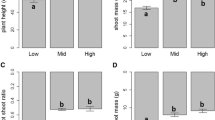Abstract
We compared seasonal growth patterns and nutrient (N, K, Ca, Mg, Fe, Mn, Cu, Zn, Pb) uptake ofPhalaris arundinacea in an unpolluted wetland (Ithaca site) to those growing in a constructed wetland (Fenton site) receiving landfill leachate. Winter aboveground living biomass was higher at Fenton than at Ithaca probably owing to the longer growing season at Fenton caused by the warm leachate, which averaged 4–8°C during the winter. Uptake of nutrients was also greater at Fenton, with aboveground and belowground N uptake by plants approximately 35 g m−2. Such uptake means thatP. arundinacea over the total area of the beds may utilize about 10% of the yearly N input and lesser amounts of other nutrient elements.
Similar content being viewed by others
Literature Cited
Armstrong, W 1967. The oxidizing activity of roots in water-logged soils. Physiologia Plantarum 20:920–926.
Bernard, J. M. 1990. Life history and vegetative reproduction inCarex. Canadian Journal of Botany 68:1441–1448.
Bernard, J. M., F. K. Seischab, and G. Jacoby. 1985. Life history and production of above- and below-ground structures ofCladium mariscoides (Muhl.) Torr. in a western New York fen. Bulletin Torrey Botanical Club 112:288–294.
Bouldin, D. R., J. M. Bernard, and T. E. Lauve. 1993. Leachate treatment system using constructed wetlands, Town of Fenton sanitary landill, Broome County, N. Y. Final Report to New York Energy Research and Development Authority No. 94-3.
Braxton, J. W. 1981. Nitrogen and phosphorus accumulation and biomass production in a meadow-marsh-pond sewage treatment system. Ph.D. Dissertation, Rutgers, the State University of New Jersey, New Brunswick, NJ, USA.
Brix, H. and H. H. Schierup. 1989. The use of aquatic macrophytes in water-pollution control. Ambio 18:100–107.
Bouyoucos, G. J. 1936. Directions for making mechanical analysis of soils by the hydrometer method. Soil Science 42:225–230.
Conway, V. M. 1936. Studies in the autecology ofCladium mariscus R. BR. I. Structure and development. New Phytologist 35:177–205.
Cooper, P. F. and B. C. Findlater (eds.). 1990. Constructed wetlands in water pollution control. Proceedings of the International Congress on Use of Constructed Wetlands in Water Pollution Control, Cambridge, England. Pergammon Press, Oxford, UK.
Crowder, A. A. and S. M. Macfie. 1986. Seasonal deposition of ferric hydroxide plaque on roots of wetland plants. Canadian Journal of Botany 64:2120–2124.
Fiala, K 1971. Seasonal changes in the growth of clones ofTypha latifolia in natural conditions. Folia Geobotanica Phytotax 6:255–270.
Fiala, K. 1978. Underground organs ofTypha angustifolia andTypha latifolia, their growth, propagation and production. Acta Scientiarum Naturalium Brno 12:1–43.
Fungaroli, A. A. and R. L. Steiner. 1979. Investigation of sanitary landfill behavior, Vol. 1. U.S. Environmental Protection Agency, Cincinnati, OH, USA. EPA-600/2-79-053a.
Grace, J. B. and R. G. Wetzel. 1981. Phenotypic and genotypic components of growth and reproduction inTypha latifolia: experimental studies in marshes of differing successional maturity. Ecology 62:789–801.
Grace, J. B. and R. G. Wetzel. 1982. Niche differentiation between two rhizomatous plant species:Typha latifolia andTypha angustifolia. canadian Journal of Botany 60:46–57.
Greweling, T. 1976. Chemical analysis of plant tissues. Search, Cornell University Agricultural Experiment Station Bulletin 6.
Hammer, D. A. (ed.). 1989. Constructed Wetlands for Wastewater Treatment: Municipal, Industrial, and Agricultural. Proceedings 1st International Conference on Constructed Wetlands for Wastewater Treatment, Chattanooga, TN. Lewis Publishing Inc., Chelsea, MI, USA.
Haslam, S. M. 1970. The development of the annual population inPhragmites communis Trin. Annuals of Botany (London) 34:571–591.
Hiley, P. D. 1990. Wetlands treatment revival in Yorkshire. p. 279–288.In: P. F. Cooper and B. C. Findlater (eds.) Constructed Wetlands in Water Pollution Control. Proceedings International Conference on use of Constructed Wetlands in Water Pollution Control, Cambridge, UK. Pergamon Press, Oxford, UK.
Ho, Y. B. 1979. Growth, chlorophyll and mineral nutrient studies onPhalaris arundinacea L. in three Scottish lochs. Hydrobiologia 63:33–43.
Hurry, R. J. and E. G. Bellinger. 1990. Potential yield and nutrient removal by harvesting ofPhalaris arundinacea in a wetland treatment system. p. 543–546.In P. F. Cooper and B. C. Findlater (eds.) Constructed Wetlands in Water Pollution Control. Proceedings in Water Pollution Control, Cambridge, UK. Pergamon Press, Oxford, UK.
Kline, P. and K. Boersma. 1983. The yield, nitrogen, and nitrate content of reed canary grass, meadow foxtail and timothy fertilized with nitrogen. Canadian Journal Plant Science 63:943–950.
Mason, J. L. and J. E. Miltmore. 1970. Yield increases from fertilizer on reed canary grass and sedge meadows. Canadian Journal Plant Science 50:257–260.
Read, J. W. and J. V. Lovett. 1980. Production of two species and two interspecific hybrids ofPhalaris under irrigation in south-west New South Wales. Australian Journal Experimental Agricultural Animal Husbandry 20:181–188.
Roseff, S. and J. M. Bernard. 1979. Seasonal changes in carbohydrates in tissues ofCarex lacustris. Canadian Journal of Botany 57:2140–2144.
Taylor, G. J., and A. A. Crowder, and R. Rodden. 1984. Formation and morphology of an iron plaque on the roots ofTypha latifolia grown in solution culture. American Journal of Botany 71:666–675.
Trautman, N. M., J. H. Martin, K. S. Porter, and K. C. Hawk, Jr. 1989. Use of artifical wetlands for treatment of municipal solid waste landfill leachate. p. 245–251.In D. A. Hammer (ed.) Constructed Wetlands for Wastewater Treatment: Municipal. Industrial, and Agricultural. Proceedings First International Conference on Constructed Wetlands for Wastewater Treatment, Chattanooga, TN. Lewis Publishing Inc., Chelsea, MI. USA.
van der Valk, A. G. and C. B. Davis. 1978. Primary production of prairie glacial marshes. p. 21–37.In R. E. Good, D. F. Whigham, and R. L. Simpson (eds.) Freshwater Wetlands, Ecological Processes and Management Potential. Academic Press, New York, NY, USA.
Author information
Authors and Affiliations
Rights and permissions
About this article
Cite this article
Bernard, J.M., Lauve, T.E. A comparision of growth and nutrient uptake inPhalaris arundinacea L. growing in a wetland and a constructed bed receiving landfill leachate. Wetlands 15, 176–182 (1995). https://doi.org/10.1007/BF03160671
Received:
Revised:
Accepted:
Issue Date:
DOI: https://doi.org/10.1007/BF03160671




